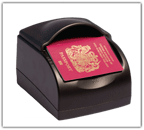The e-passport’s significant impact on electronic identity documents
20 December, 2005
category: Biometrics, Government
 A panel of ID industry experts provided predictions for 2006. One of these glimpses into the future will appear here each day during December.
A panel of ID industry experts provided predictions for 2006. One of these glimpses into the future will appear here each day during December.
By Greg Pote, Chairman, Asia Pacific Smart Card Association (APSCA)
Industry news is now dominated by the ICAO e-passport. In the future we will see the impact of this standardization and development work on other public and private sector electronic identity documents. Previously there was no obvious direction for governments selecting smart card technologies for national ID card programs. They could only specify their business requirements and then evaluate proposals from the industry, suggesting chip products and architectures, chip operating systems, file and data structures, memory sizes, biometric systems, readers and contact or contactless technology. The same absence of any standard or technology direction has caused a mass of uncoordinated initiatives attempting to enhance aviation security and airline passenger facilitation.
New drivers for smart ID card technology development
The standardization and development of the ICAO e-passport will impact the identity, border clearance and passenger processing functions of other electronic identity documents. National smart identity cards and electronic passports will converge in these areas. Airline passenger facilitation will be based on the ICAO e-passport infrastructure. Many other government electronic identity documents such as driver’s licenses, health cards, and social security cards will consider the technical and standardization development (good and bad) of the ICAO e-passport.
Contactless technology
The New Technologies Working Group (NTWG) of the ICAO Technical Advisory Group for Machine Readable Travel Documents (TAG/MRTD) has worked with suppliers to enable contactless technology to be used in passports. A number of issues needed resolving before the contactless technology and ISO14443 standard originally developed for transport cards could be used in secure identity documents. That work continues. Importantly, the size of the passport market and the ICAO (and USA visa waiver) requirement for states to issue chip-based machine-readable passports has effectively defined the business case necessary for suppliers to justify investing in research and development of new contactless electronic identity products. There is now a real supply chain for contactless chips for passports and these chips could also be used in other contactless ID card infrastructures.
Operating systems and file structures
ICAO has defined a Logical Data Structure (LDS) on which all ICAO-compliant e-passports must be based. This has effectively standardized the development and interoperability of e-passports. Other electronic ID cards may make use of the ICAO LDS. The leading multi-application smart card operating systems, MULTOS and Java Card, were previously only available for contact smart cards. Both platforms are now available in fully contactless solutions for e-passport, thus enabling fully contactless multi-application cards for national ID and other applications.
E-passport readers
The need for UN states to roll out an infrastructure of ICAO-compliant chip readers at border control points is also creating a substantial market for contactless readers for passports. The lessons learned by vendors in developing these products, as well as the market volumes available to support the development, will make it feasible to develop the supply chain for contactless smart card readers for other contactless government and commercial electronic identity documents.
Chip Memory Size Suppliers have responded to the ICAO recommendations with a variety of 64KB+ contactless chip offerings (and at least one 1MB contactless chip) and this may increase with the requirement to store biometrics in raw form. These memory sizes will be sufficient for most other contactless electronic identity applications.
Biometrics
Although the ICAO recommendations for biometric storage have resulted in contactless chips with plenty of memory, this is for the wrong reasons. It would have been better to define an international standard for biometrics that did not require storage of the raw images. The International Labor Organization (ILO) has successfully accomplished this for their Seafarer ID Document. The storage of raw biometric images will result in problems that will have to be solved later. National and commercial contactless electronic identity documents are likely to use pattern-based or minutiae-based biometric templates.
Conclusion
The ICAO e-passport standardization and development work has been, and continues to be, rapid. Public and private sector organizations planning to issue electronic identity documents and cards need a thorough understanding of these issues, including future directions. National identity documents, including public and private sector “frequent traveler cards” and registered traveler schemes, will be heavily influenced by this new generation of contactless travel documents.
Identity documents issued by airlines for ticketing, boarding and passenger facilitation will necessarily need to be based on the new e-passport documents. It was for this reason that Asia Pacific countries began organizing the annual Government Discussion Forum on Electronic Identity Documents–a gathering of senior government officers responsible for identity cards, passports and border control. From the industry perspective, suppliers are currently heavily focused on meeting the demands of the e-passport market. As the supply chain stabilizes they will begin to look at how they can maximize their returns from development of these technologies with other related schemes, including government smart ID cards, driver’s licenses and commercial passenger facilitation/aviation security schemes.
Visit the Asia Pacific Smart Card Association on the web at www.apsca.org.




